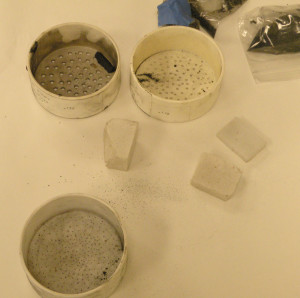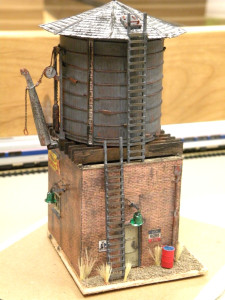Article and photos by Ken Liesse
(Author’s note: My apologies for this report being so tardy. Apparently, I hit the Preview button when I thought I was hitting the Publish button.)
At the regular get-together on October 20th, the Eastside Get-Together was treated to a 2-for-1 clinic by noted local modeler Glenn Farley. Glenn showed us how to make coal loads using actual coal as well as showing us how to add lights to our locomotives. For the coal loads, start by measuring the opening on whatever car is going to receive the load. Then cut a piece of foam (Glenn used white, but pink or blue would work as well) the size of the opening and give it the contours of the coal load.
Older cars would have distinct piles of coal in the load as the car would have been spotted under a tipple for each dump; modern cars would have a neater, even appearance as they continuously move under a flood loader. After the foam has been shaped, paint it black with acrylics and dust it with Woodland Scenics coal for a base. Glenn prefers to use real coal for the actual load. Since he models the Colorado-New Mexico area, he brought some coal that had been “liberated” from that area. Put the coal in a plastic bag to scale it for the load (read: pulverize with a hammer). Glenn recommends using two or three layers of bags in case any of them break during the process. Drill holes in the bottom of PVC pipe end caps to use as sifters – the holes should be no bigger than the largest lump of coal you want in your load. Sift the pounded coal, paint the base with Dullcote and pour on the coal. Allow the load to dry, then add stand-offs of the proper height to the car. This allows the load to be removed without ruining the appearance of the empty car.
For the second part of the clinic, Glenn described how he modifies MV lenses for use in his locomotives, giving them a uniform appearance. Start by making a dimple in the back of the MV lens (which are getting harder to find, unfortunately) and drill out the back with a bit the same diameter as your light bulb. Test fit the bulb and use CA to adhere it to the ends. Run the leads where they need to go and voila! Headlights. Glenn also modifies this approach for special circumstances as well, gluing the bulb perpendicular to the plane of the headlight to make it easier to run the wires. This works well on short headlight fixtures that would not leave any room to run wires out the back. Finally, Glenn showed us a commercial that was made for the upcoming 2012 Narrow Gauge Convention.
This, of course, was all preceded by the usual business of the clinic. JJ opened by pointing out all the MMRs in attendance as well as the 4D and PNR staff on hand. We then held a moment of silence for Bobj Berger’s father, who passed away a few days before. Our thoughts go out to Bobj and his family.
Your superintendent (that would be me) made sure everyone knew about the upcoming increase in NMRA dues and encouraged folks who could do so to prepay their dues before the end of the year. Also, don’t forget to send in your survey from the NMRA Magazineon the possibility of a cruise for the NMRA 2016 convention. These are being collected by Di Voss.
Di announced that the NMRA now has new standards and new track gauges. The new gauges are more era specific and come in Old, Classic, and Modern. Russ Segner brought in photos from projects in Dupont and Snoqualmie on which he is currently working. Russ is always looking for more volunteers who would like to try their hand at modeling in 12″:1′ scale (the real deal). He also pointed out that Ken Larson, a modeler who lives across the Sound in Winslow, is featured in this year’s Great Model Railroads.
Roger Ferris, in addition to bringing the Mart, stated that he had duplicate books from his own collection with which he was parting. Contact Roger for the details. Ed Liesse finished the announcements with a reminder to everyone about the Joint PCR-PNR Convention being held in Medford, OR next May 2-5. After resolving issues with the convention website, the committee decided to extend the early-bird pricing to the end of November, so if you haven’t signed up yet, do so before the end of the month and get the discounted price. Visit the website at http://www.pcrnmra.org/conv2012/
There were five entries in the Model of the Month contest, which was won by David Yadock for his water tower. Congratulations, David.
Next month’s clinic will be on November 17th, with the topic to be determined. We will start collecting for our annual donation to the church, which provides us with the space to hold our meetings every month. The collection will go to the church’s outreach program to help those in need within the church community to have a Christmas.



No Comments Yet